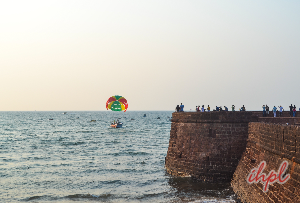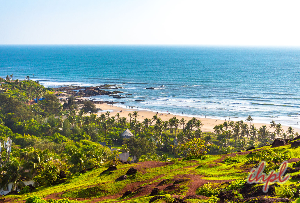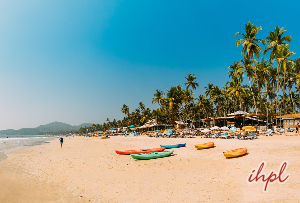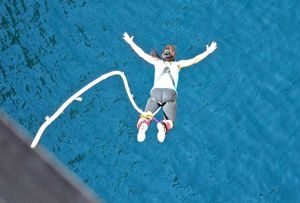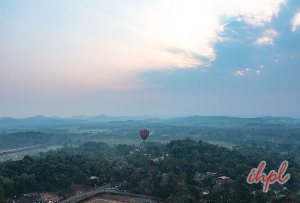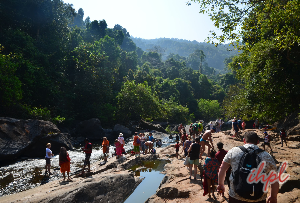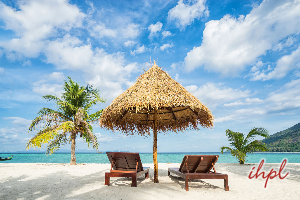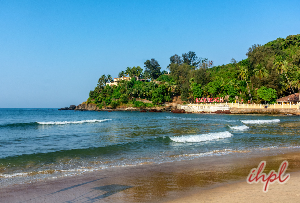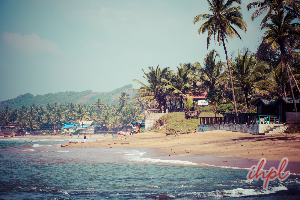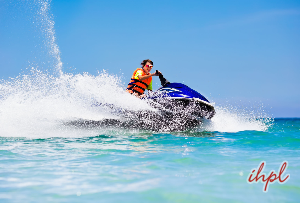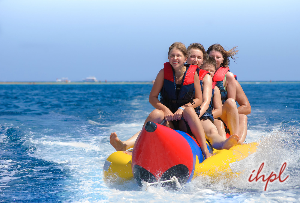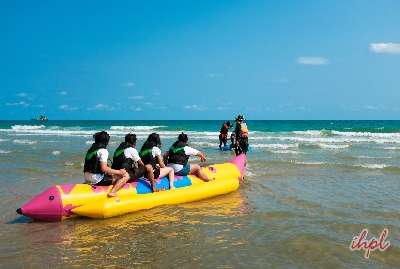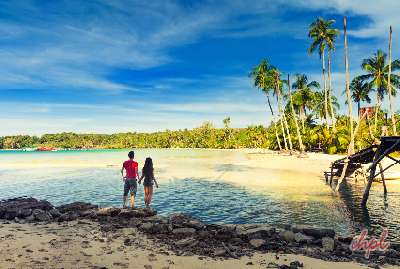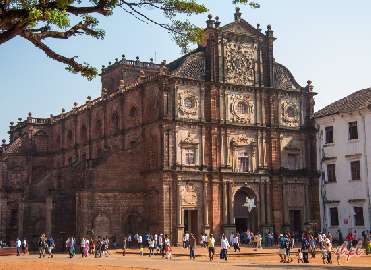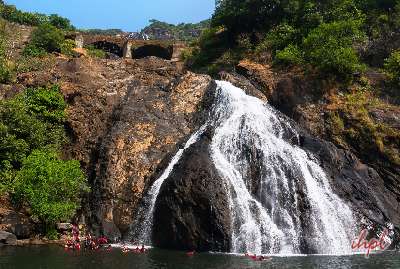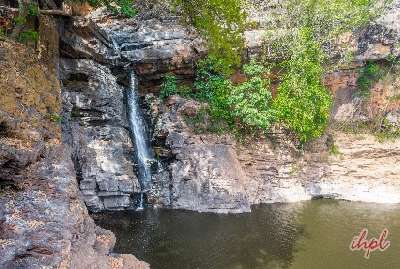Presenting the mesmerizing views of the Arabian sea and Goan coastline, Cabo De Rama Fort is situated in the South Goa district in Canacona town. The entry to the fort is free of cost for all, which makes Cabo De Rama Fort the must-visit place in South Goa. The fort is an engineering marvel where you can witness the sweeping views of the Arabian Sea and Goa's coastline. Next to the fort is Cabo De Rama Beach, which is a perfect place to refresh your mind, body, and soul after a hectic fort exploration. Today, the whole fort is in ruins, but there is one church inside the fort Saint Antonio Church which is not in ruins and could be visited.
The fort is now in ruins and is sandwiched between Cavelossim Beach and Agonda Beach. Legendary stories depict that this was the same place where Lord Rama and Sita spend their part of the exile days together, and thus, the fort has got "Rama" in its name. It is believed that initially, Cabo De Rama Fort was built by Hindu rulers, but with time, many other powers made this fort their commanding seat.
Cabo De Rama Fort has witnessed many historical battles in the past. The local Soonda rulers in 1763 restored the fort. And later, it was used by the Portuguese for carrying out military operations. In the bygone era of Portuguese rulers, the fort had a commandant's room, military barracks, and chapel. When the fort came into British power in the next few decades, they used it as a prison from 1935 to 1955.
A visit to Cabo De Rama Fort in South Goa is like transporting yourself to a forgotten part of history. Although the fort is in ruins, tourists still consider it an engineering marvel. At the fort entrance, there is the bridge which has been standing in its glory for more than 300 years ago!
A well-guided trip to the Cabo De Rama Fort in South Goa is more about seeing bastions where large cannons were placed to stop the invasion of the enemies from the sea.
History of Cabo De Rama Fort
The construction of this fort was started by the Hindu rulers. But in the 1760s, Portuguese power gained control over Cabo De Rama Fort after making the Raja of Sonda surrender his territory. It was done because Hindu rulers and Portuguese rulers had mutual consent to protect Hindu rulers against the Hyder Ali of Mysore. However, before the Portuguese finally gained full control over the Cabo De Rama Fort in 1763, several other powers in between tried to rule the fort.
Portuguese rulers carried out the fort's restoration work to equip it with 21 guns and installed military barracks followed by a commander's quarter and a chapel. Under Portuguese rule, Cabo De Rama Fort was used as a military base and a prison for a while. Lastly, they built a church inside the fort premises for which the Portuguese were recognized!
Legends of the Cabo De Rama Fort
The legends and lore of the Cabo De Rama Fort were associated with the hero of the Ramayana, Lord Rama, his beloved wife Sita, and his brother Laxman. It is said that they took refuge during their exiled years from Ayodhya. That is how the Cabo De Rama Fort got its name.
The architecture of Cabo De Rama Fort
Laterite rock was used in the construction of the Cabo De Rama Fort. One would be amazed to see the architecture of the Cabo De Rama even if it is now in ruins. When you enter the fort, there is a bridge to be found at the entrance. This bridge dates back to 300 years old (approx.) and is one of the finest engineering marvels you could ever see. From noticing iron bastions to cannons and watchtowers, the Cabo De Rama Fort and its architecture is sure to spellbind you!
Within the fort premises, two ponds represent Hindu mythology and architecture. These ponds were built in the era of the Soonda Kings. Also, upon looking carefully, you will find ruins of the army quarters inside the fort.
Opening Timings of the Cabo De Rama Fort
The fort is open daily from 9:00 AM to 5:30 PM every day! The timings are subject to change anytime by the Goan tourism department if they feel like it needs to be revamped for any reason - be it festive or any other motive.
How to Reach Cabo De Rama Fort: From Panjim, and Its Nearby Towns
Cabo De Rama Fort is in South Goa. If you are staying in South Goa, hire a private cab, auto-rickshaw to reach the fort. If you are coming from Panjim, the nearest bus stand is Panjim Kadamba Bus Stand, 60 kilometers/1.5 hours (approx.). Those coming from Mumbai and nearby towns of Goa via train can arrive either at Vasco Da Gama Railway Station, 58 kilometers (approx.) from Vasco Da Gama Railway Station, and 27 kilometers (approx.) from Margao Railway Station.
From Dabolim Airport: It is Goa's only international airport with good flight connectivity with almost every major metro town of India. Moreover, a few of the notch international destinations are well connected with the Dabolim Airport. The travel distance and time duration between them is around 55 kilometers (approx.).
When is The Best Time to Visit Cabo De Rama Fort?
November to March is the best time to visit Cabo De Rama Fort because the weather remains cool and pleasant. It is the winter season. Afterward, in March, summer arrives, and the scorching sun is sure to trouble you with its average high upto 38 degrees celsius (approx.) from April till June. You can't enjoy the sightseeing of the fort except early morning and evening before 5:30 PM. After that, monsoon strikes from July till September, which is another good time to go to Cabo De Rama Fort. Watch and hear the crashing sounds of the Arabian Sea from the fort walls when the monsoon is at its peak.
What to See at Cabo De Rama Fort
Church Exploration Within the Premises:The fort, which sprawls over 180,000 sq.m (approx.), has a small St Antonio Church within its premises. Annually, locals accumulate together on special days to offer prayers. Attend the prayers offering ceremony on special occasions like Christmas and Easter.
Behold the Sweeping Views of the Arabian Sea:A small path from the fort leads you to the Cabo De Rama Beach, where you can delve into watersports and take romantic strolls. Well, if you don't want to unwind at the beach, behold the sweeping views of the Arabian Sea from the fort courtyard. Sunsets and best observed at Cabo De Rama Fort on South Goa trip.
What Else to Do Nearby to Cabo De Rama Fort
- Spend peaceful hours at Cabo De Rama Beach.
- Head to the South end of Palolem Beach to learn Yoga lessons.
- Bewitch your mind with lush greenery on a trip to Conco Island for watersports.
What Are the Popular Restaurants Near Cabo De Rama Fort?
Within 1 kilometer to 10 kilometers (approx.), you will find the most popular restaurants near Cabo De Rama Fort. Most of them serve continental food like Italian, Chinese, Israeli, and more! Plus, you can relish local Goan sea food also! Have a look at the best restaurants around Cabo De Rama Fort:
Tree Top Tava: Within 8 kilometers (approx.) to Cabo De Rama Fort is Tree Top Tava. It serves lip-smacking seafood plucked straight out of the Arabian Sea. Meals for two here start at 200 INR (approx.).
Red Crab Seafood Restaurant:Best for breakfast, lunch, and dinner, Red Crab Seafood Restaurants serves drool-worthy seafood. You don't need to venture far because this restaurant is located around 1 kilometer (approx.) near Cabo De Rama Fort.
Dine at The Cape Goa:Combine delicious sea food with the panoramic views of the Arabian Sea at this restaurant to go round Cabo De Rama Fort. Dine at the Cape Goa servers meals for two starting at 800 INR (approx.).
Important Travel Tips to Know Before Visiting Cabo De Rama Fort
- Keep yourself hydrated through the fort exploration.
- Carry a good camera with extra batteries.
- Avoid public displays of affection.
- Check the weather forecast before visiting.
- April till July is when day sightseeing of the fort will trouble you coz of the sun.
- October till March is the cool time to visit the fort.
- Go on a guided trip to the fort for a better understanding of the historical events.

